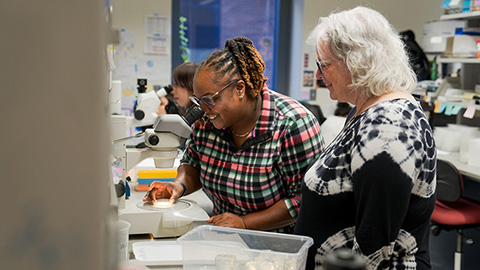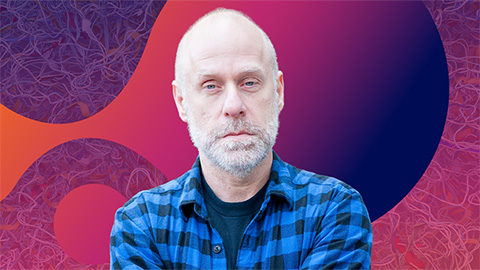JBC: Blocking potato blight’s ability to set up shop
True to its name, Phytophthora infestans is a destroyer of plants. (In Greek, “phyto” means “plant”; “phthora” means “ruin.”) Most notorious for the Irish potato famine, the pathogen also can target other members of the Solanaceae family of plants, which includes tomatoes, spices, weeds, herbs and vines. While a global, potato-based famine isn’t imminent, the pathogen still causes about $6 billion of damage to crops of the versatile tubers each year, according to the American Phytopathological Society.
In a Paper of the Week recently published in the Journal of Biological Chemistry, researchers in the U.K. report detailed crystallographic information about the interaction between one of the pathogen’s effector proteins and one of the potato’s proteins. They ultimately hope to exploit this result to engineer plants that are resistant to the pathogen.

A potato showing the characteristic signs of blight.
AGRICULTURAL RESEARCH SERVICE
“If you can understand interactions and then modify the host–cell target in such a way that it retains its original function in the plant, but is no longer able to be acted on by the effector, that might push the balance of the disease progression in the favor of the plant,” says Mark Banfield at the John Innes Centre, the senior author on the paper.
According to Banfield, the effectors, which tend to be small proteins that bind to specific host proteins and modify their activity, often possess dual activities for host and pathogen. “One of them is to work on behalf of the pathogen to manipulate host cells for their own benefit,” he says. “But the plants have also evolved ways of recognizing the presence of these molecules as foreign objects inside cells and then are able to mount a response to those molecules directly.”
Banfield and his colleagues at the Sainsbury Laboratory Norwich and the Imperial College London, with whom he collaborated on the current paper, previously had characterized the PexRD54 effector protein of Phytophthora infestans and verified its interaction with the host cells’ ATG8 proteins. Their characterization appeared in the journal eLife earlier this year.
ATG8 is a protein located in the membranes of eukaryotes’ autophagosomes, which are double-layered membrane organelles involved in delivering damaged cellular structures to the lysosomes for degradation, among other functions. PexRD54 works on behalf of the pathogen by binding to this protein in host cells and interfering with its ability to perform its normal cellular function.
For this JBC paper, the investigators wanted to explore further the interaction. The researchers first determined the crystal structure of PexRD54. They then focused on the protein’s disordered C-terminus, a region of around 10 to12 amino acids that the researchers knew bound directly to the ATG8 molecule, and used X-ray crystallography to show the complex.
With the components of the linked region well defined, they then turned to a low-resolution technique known as small-angle X-ray scattering to get an image of the surface of the entire bound protein complex. They were then able to dock the separately defined features, including the individual proteins and the interacting region, into the protein surface, forming a complete image of the interaction.
With this interaction now well characterized, Banfield and his colleagues hope to engineer the ATG8 protein to ignore the presence of the PexRD54 effector from the pathogen.
“If we can engineer that molecule in the plant cell to no longer be perturbed by the presence of the effector, clearly the pathogen has then lost the benefit of delivering that effector to host cells,” Banfield said. “It goes all the way to delivering it, but it no longer has the activity that it’s evolved to have.”
Enjoy reading ASBMB Today?
Become a member to receive the print edition four times a year and the digital edition monthly.
Learn moreGet the latest from ASBMB Today
Enter your email address, and we’ll send you a weekly email with recent articles, interviews and more.
Latest in Science
Science highlights or most popular articles

Fueling healthier aging, connecting metabolism stress and time
Biochemist Melanie McReynolds investigates how metabolism and stress shape the aging process. Her research on NAD+, a molecule central to cellular energy, reveals how maintaining its balance could promote healthier, longer lives.

Mapping proteins, one side chain at a time
Roland Dunbrack Jr. will receive the ASBMB DeLano Award for Computational Biosciences at the ASBMB Annual Meeting, March 7–10, just outside of Washington, D.C.

Exploring the link between lipids and longevity
Meng Wang will present her work on metabolism and aging at the ASBMB Annual Meeting, March 7-10, just outside of Washington, D.C.

Defining a ‘crucial gatekeeper’ of lipid metabolism
George Carman receives the Herbert Tabor Research Award at the ASBMB Annual Meeting, March 7–10, just outside of Washington, D.C.

The science of staying strong
Muscles power every movement, but they also tell the story of aging itself. Scientists are uncovering how strength fades, why some species resist it and what lifestyle and molecular clues could help preserve muscle health for life.

Bacteriophage protein could make queso fresco safer
Researchers characterized the structure and function of PlyP100, a bacteriophage protein that shows promise as a food-safe antimicrobial for preventing Listeria monocytogenes growth in fresh cheeses.

